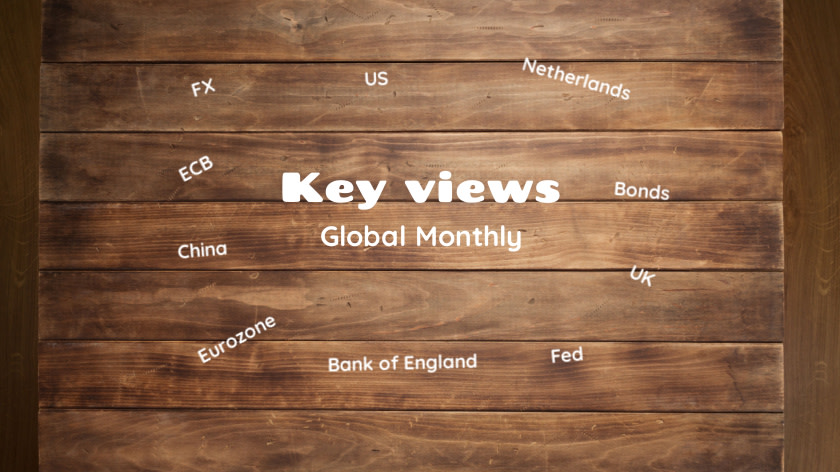Key views Global Monthly May 2025

The US and China have significantly de-escalated their trade war, bringing bilateral tariffs of 145% (on Chinese exports) and 125% (on US exports) down to 30% and 10% respectively. However, global trade is still likely to slow sharply as the tariffs that remain take their toll, and frontloading effects unwind, while the global economy (especially the US) will be weighed by extreme policy uncertainty. Interest rate cuts and other forms of policy support are a cushioning factor in the eurozone and China, while in the eurozone specifically, defence spending, and in Germany new infrastructure spending will support growth in 2026. Still, the nascent recoveries in domestic demand in the eurozone and China face downside risks from weaker confidence, while in the US, demand will be hit by the tariff impact on real incomes. Inflation in the US is expected to reaccelerate, but to fall below target in the eurozone. This is likely to drive a divergence in Fed & ECB policy, with Fed policy staying on hold until 2026, and the ECB continuing to cut rates.
Macro
Eurozone
Growth is likely to slow to a below trend rate on the back of an unwind of US export frontloading, though our base case sees domestic demand (helped by rate cuts) keeping the economy growing solidly. Next year, higher defence spending and German infrastructure spending are likely to drive much higher growth. Disinflation is also continuing, with services inflation less of a worry, and wage growth continuing to cool. Tariffs are likely to drive an undershoot of the 2% inflation target by the end of this year, helped by a stronger euro and falls in energy prices.
The Netherlands
Growth slowed to 0.1% q/q in 2025Q1 and shows a poor start to the year before US tariffs hit. Generally, the Dutch economy can take a beating, as its fundamentals are strong. Due to the (in)direct effect of tariffs and related uncertainty, growth will cool over the course of 2025. In 2026, higher defence spending in the eurozone and fiscal spending in Germany, as well as rate cuts feeding through to the economy, will provide an upside to growth. Unemployment will continue to gradually tick-up, but the labour market will stay tight in historical perspective. Inflation will stay above the 2% target.
UK
Government spending and rising real incomes are likely to keep the economy on a recovery path for now, but structural challenges remain. The UK is less vulnerable to US tariffs than the eurozone as it is less export dependent, and it faces a lower reciprocal tariff of 10% vs the threatened EU tariff of 20%. Services inflation is stubbornly high, with wage growth still well above levels consistent with 2% inflation. A sustained return to 2% inflation will take longer than elsewhere, due to historically higher inflation expectations in the UK.
US
Recent de-escalation in the trade war notwithstanding, remaining tariffs and elevated uncertainty will slow down the economy. Over the next quarters, the impact of the Trump administration's policy will feed into the hard data. We expect growth to slow down to 1.5% in 2025 and 1.2% in 2026. Tariffs will lead to an increase in PCE inflation to 3.3% by year end. Effects in the labour market remain relatively muted, rising by about half a percentage point by year end, as lower labour demand is paired with lower labour supply due to lower immigration.
China
April data show the impact from the US-China trade war escalation, following an acceleration in March helped by trade frontloading and support. We expect growth momentum to pick up again, following the Geneva truce. April export data confirm our view that the export shock to the US is being miti-gated by trade circumvention/diversification. The sharp tariff reduction will soften a key drag, although tariffs are still higher than before Trump 2.0, uncertainty remains and Beijing may reduce extra stimulus a bit. All told, we raise our 2025/2026 growth forecasts to 4.7% and 4.2% (from 4.1% and 3.9%).
Central Banks & Markets
ECB
The Governing Council cut rates again in April, in a unanimous decision. The tone in the press conference was dovish, reflecting the tariff hit to the growth outlook. More importantly, the April cut revealed a more dovish reaction function to tariffs; before, some Governing Council members still favoured a pause. Given the growth and inflation outlook we expect a further 75bp in rate cuts, taking the deposit rate to 1.5% by September. With looser fiscal policy expected to lift growth from late this year onwards, the Governing Council is likely to keep policy on hold in 2026.
Fed
The Fed’s upper bound on fed funds rate stands at 4.5%. In the short run, the massive amount of uncertainty about policy and pass-through to the real economy keeps the Fed from changing rates. In the medium-term, the price stability mandate will carry more weight than the employment mandate, such that the Fed will keep rates restrictive. With current policy, keeping rates at their current level for an extended period will be sufficient to bring back inflation to target in the longer run. This will allow the Fed to start easing in the second quarter of 2026, by 25bps per quarter.
Bank of England
The MPC cut Bank Rate to 4.25% in May, in line with our expectations. Incoming data suggests stubbornly high underlying inflationary pressure, and sticky wage growth. The government’s expansionary fiscal stance, alongside continued elevated wage growth, poses upside risks to medium-term inflation. This is likely to keep rate cuts at a more gradual pace than for the ECB. We expect two more 25bp rate cuts in 2025 with the next cut expected in August. Bank Rate is expected to settle at 3.5% in early 2026.
Bond yields
Over the past few weeks, US Treasuries underperformed EU government bonds. US term premium has risen sharply leading to higher Treasury yields. This is primarily driven by a growing lack of confidence among investors regarding the US economy and government policy. Conversely, European government bonds have benefitted from this shift. Given the frequent policy U-turn by the US government and the volatility these changes trigger, we maintain a bullish stance on EU rates and recommend caution regarding US bonds at this time.
FX
We have downgraded the US dollar across the board. We now expect more weakness this year and next year. The reasons are as follows. Higher risk premia in the US resulting in higher US yields are not supportive for the dollar. In addition, US administration domestic policies have resulted in an unfavourable growth inflation mix. Furthermore financial markets also focus on unsustainable US debt dynamics. Our new forecast for EUR/USD end 2025 is 1.15 (was 1.08), and end 2026 is 1.25 (was 1.15).

